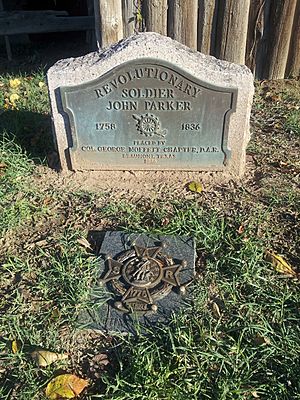John Parker (pioneer) facts for kids
John Parker (born September 6, 1758 – died May 19, 1836) was an important figure in early American history. He was a minister, a veteran of the American Revolutionary War, a scout, and a diplomat for the U.S. government. He was also a well-known Texas Ranger on the frontier.
John Parker was one of the first American settlers in Texas before the Texas Revolution. Sadly, he was killed during the Fort Parker massacre in 1836. Several members of his family also died in this event.
Contents
Early Life and Frontier Moves
Growing Up in a New Nation
John Parker was born in 1758 in Baltimore County, Maryland. When he was young, his family moved to the frontier of Virginia. The frontier was the edge of settled land, often wild and undeveloped.
John Parker joined famous explorers like Daniel Boone. They explored new lands that are now Kentucky and Tennessee.
Fighting for Freedom
In 1777, the British and Native American groups launched attacks on American frontier families. Many people, including Parker's family and friends, were killed. Because of this, John Parker joined the American Revolution to fight for two years.
American settlers defended themselves in forts and settlements. They fought back against attacks. In November 1779, John married Sarah "Sallie" White. After he returned from the war, their first child, Daniel Parker, was born in 1781. He was named after Daniel Boone.
Moving to Georgia
After the war, Native American groups continued to attack frontier families. John's wife, Sallie, encouraged him to move for safety. Around 1785, the Parker family moved to Georgia. They hoped to find a safer and better life there.
Life in Tennessee
However, attacks continued, sometimes encouraged by Spanish and British powers. John Parker became a frontier ranger again. He took part in raids against the Cherokee and other Native American groups. After these conflicts, more land in the Appalachian area opened up for American settlers.
In 1803, John Parker moved his family again. They settled near Nashboro, which is now Nashville, Tennessee. He received land for his service in the War of Independence. By 1817, his family had grown to eleven children. Many of them were married and had their own children.
Settling in Illinois
More land became available after conflicts in what is now Southern Illinois. John Parker received more land for his service in the Northwest Indian War. So, his family moved to Illinois. They helped with land development and other important activities in the state.
In 1824, his wife Sallie died. In 1825, John Parker married Sarah "Sallie" Duty. She was a widow with daughters who had married into the Parker family.
Journey to Texas
A New Frontier in Texas
By age seventy-five, John Parker was a well-known frontiersman and patriot. He had served the United States government for many years. Stephen Austin and other Mexican leaders asked him to settle in Texas.
They wanted him and his family to help protect the frontier. This area needed protection from attacks by the Comanche people. After careful planning, Parker and most of his family moved to Texas in 1833.
Building Fort Parker
In 1835, John Parker used his experience in frontier defense. He talked with local Native American tribes. He also explored the area around them. With some of his sons, he helped build a fort.
The fort was built near present-day Groesbeck in Limestone County, Texas. This area was known as the Comancheria, a region where the Comanche lived. The fort was built where Comanche attacks had happened before. It was meant to protect the families who had land there. It was also meant to block future Comanche raids.
The Fort Parker Massacre
The Attack
The Parker community did not fully understand the strength of the Comanche warriors. The Comanche were known for their speed and ferocity. Sometimes, thousands of warriors would attack. In May 1836, the community was not ready for such a large attack.
On May 19, 1836, Comanche warriors quickly attacked. They killed people in outlying homes and burned down houses. Then, they headed for Fort Parker. John Parker and others tried to gather people to defend the fort.
A Brave Stand
The Comanche attack was very fast and powerful. It was clear the community was in great danger. Parker ordered women and children to escape with a few chosen men. He and other volunteers bravely went out to face the Comanche. They tried to draw the attackers away from the fort.
This brave act helped some escape. However, most of the men who went out were killed. John Parker and other survivors made it back to the fort. But the fort was not strong enough to hold off the large number of Comanche warriors.
Aftermath
John Parker was killed during the attack. His wife was seriously wounded, as was another son. They and several others escaped. They were able to warn others about the approaching Comanche group.
John Parker and four other members of his family were killed at the Fort Parker massacre. However, several of his relatives and children survived. Five family members were taken by the Comanches. One of them was his granddaughter, Cynthia Ann Parker. She lived with the Comanche nation for twenty-five years and became a member of their tribe.


